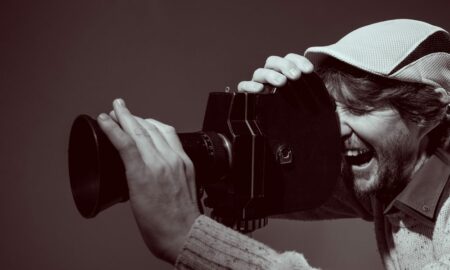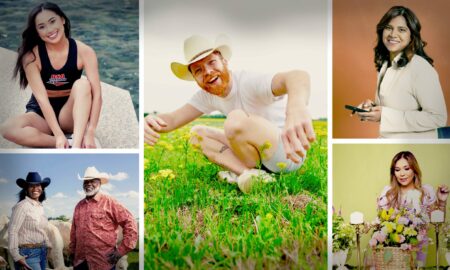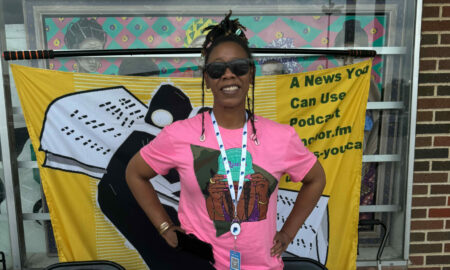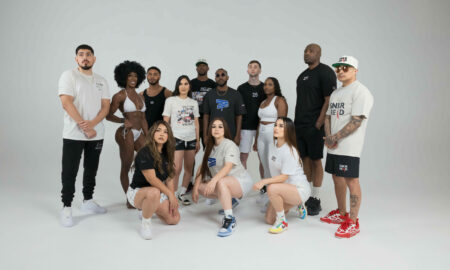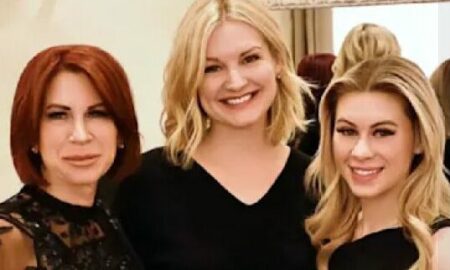

Today we’d like to introduce you to James Gilbreath.
Uniqueness should be important to every artist. Nobody wants to dress, or look, like everyone else, so artwork should be no different. The viewer should be able to look at one artist’s work and tell it apart from another artist’s work. When one looks at James Gilbreath’s unique canvases there is no doubt in anybody’s mind who is the artist.
James’ love of art began in elementary school. When other children were drawing stick figures with a blue sky and yellow sun, James was trying to flesh out their stick bodies in an, albeit, crude style. But in the fourth grade he had a teacher who used the nine-year-old’s manila paper and crayons to show the class how to show action with their drawing. This unknowing mentor did a simple drawing of a man in a suit with his tie flapping and his hat blowing in the air with the fall leaves from the trees. Young James was in awe and knew from that day, that was what he wanted to do.
Every art class he had in the duration of elementary school, then Jr. high and high school, he excelled and won ribbons. At the age of 15, James was introduced to oil painting and his love of art grew to a whole new level. His high school art teacher was an English instructor, who knew how to paint, so they gave her an art class. Under her instruction James learned the basics of art; the color wheel, perspective, lines, shapes, space, focal points, etc. It was a good foundation, but she painted realism and that was what she wanted her students to paint. She would stifle the use of imagination by giving out C’s to the students who used theirs in her class.
So James painted realism and he discovered that he was good at painting what he saw. Family members began to inundate him with photographs to paint for them. He began to crank out painting after painting and his work began to show his ennui. He began to realize he wasn’t being creative. “I wasn’t painting ‘paintings.’ I was painting pictures of pictures.”
After he graduated from high school, James stopped painting. He didn’t enjoy it and he didn’t want to do it anymore. If a family member brought him a photo wanting a painting, he would quickly throw together “a tripe, flat piece of useless junk.”
When he was twenty years old he went back to school and took art classes with instructors who actually encouraged the students to use their imaginations. He began to enjoy what he had come to hate. His work was very stiff and his teachers tried very hard to get him to loosen up. When he got into watercolor classes, he began to finally loosen up, but he would eventually fall back into old habits. Despite that, he began to enjoy the process and knew that painting was what he was always going to do and an artist is what he would always be. His love for this elusive vocation would grow over the years and decades. He always carried a camera and took photo after photo to find that perfect scene to paint. His main topics would be Southwest landscapes, gnarly trees and cityscapes.
Then, after fifty years of painting, James met Willis Davis, a successful abstract artist. That day became an Epiphany. “My love for painting moved to a whole new level. I finally found that elusive thing I had been unknowingly searching for; Abstract Art. Instead of painting a picture of something, I was now painting something on canvas that did not exist before I created it. I began using that imagination that had been stifled so many years before. My realism and abstract began to blend together to a more open and fresh look and I have never enjoyed painting more than I do now.”
James’ paintings adorn walls from Houston to San Antonio to Fredericksburg, Texas and, of course, all around the DFW area where he lives. Each of his paintings tells its own story, which, as is the nature of abstract, is different for every individual set of eyes that behold it.
Can you give our readers some background on your art?
My artistic life has been all over the board beginning in the sixties, when, at the age of 16, I started out oil painting from photos given to me by almost every member of my family. In those early days I never painted what I wanted, mainly because I didn’t know what I wanted. I just painted.
When I finally did paint something I wanted, my high school art teacher showed it to the class and said she liked my color scheme and my perspective was perfect, but she was giving me a “C” because of the “subject matter.” I had painted a long hallway that appeared to go into eternity and a man hanging in the foreground. I simply titled it: The Eternity of Death. So, I continued to paint from photos.
In the 70’s I wanted to break away from the mundane situation I had gotten into. I tried to paint abstracts only to have them turn in to a muddy mess. I wanted to paint surrealism and failed miserably. I soon discovered all I could do is paint what I can see. I could paint an abstract if I copied another artist’s painting. I could paint surrealism, again, if I copied another artist’s painting. So, I continued to paint from photos I took or from magazines. I became more and more frustrated as I cranked out crap, mostly for friends and family, who didn’t want to pay. And if they did, they didn’t pay much; maybe enough to cover the materials. Finally, after 50 years of painting realistic “pictures” from photos and seriously believing I was enjoying it, I met Willis Davis, a successful abstract artist. That meeting in January of 2015 was an epiphany for me. I now realize the total joy of painting.
I am now using something in my art that had been lacking; My Imagination. That, linked with my years of painting landscapes, allows me to create a unique piece instead of a copy. Like many artists I used to be constantly searching for my Muse. But now I am allowing the paint to become my Muse. I start on each fresh surface with an open mind. I prepare my pallet and begin to push the paint around and it lets me know where it wants to go. As ideas emerge I bring them to the surface where I can define and refine them with details.
One thing you’ll notice in my body of work; I don’t do the same thing over and over. I get bored. I like to do realism for a while, then I do abstract, then I do abstract realism. I know artists who only do blue bonnets. I know artists who only do horses. I know artists who only do portraits. They do fantastic blue bonnets and horses and portraits. They are the best. I can do blue bonnets and horses and portraits. Not as well as the aforementioned artists, but they are passable. But can they do other things? Can they paint abstracts for instance? Perhaps. Perhaps not. The important thing is they are happy doing what they do. And I am happy doing what I do.
What responsibility, if any, do you think artists have to use their art to help alleviate problems faced by others? Has your art been affected by issues you’ve concerned about?
I believe the internet has changed things in the art world considerably. Now your work can be seen by people all around the world. And most definitely around the U.S. But the local scene with your work being seen in person is still the best way and probably always will be. Because I have discovered nobody wants your art any more than when they are standing in front of the actually piece.
What’s the best way for someone to check out your work and provide support?
My website: www.jamesgilbreath.com
My Art Gallery in Plano @ 3309 Custer Rd. #202B (NW corner of Custer and Parker in the Kirby Place) Plano, Tx. 75023.
Some of my paintings hang in Cafe Bohemia in Plano. I have paintings hanging @ Art in the Atrium 16, which opens Monday, April 9, 2018 and runs through Friday, September 7, 2018 in Frisco, Tx.
Contact Info:
- Address: 2109 W. Parker Rd. #202B Plano, Tx. 75023
- Website: www.jamesgilbreathartist.com
- Phone: 972-758-1210
- Email: jamesgilbreathartist@gmail.com
- Facebook: James Gilbreath – A Texas Artist








Getting in touch: VoyageDallas is built on recommendations from the community; it’s how we uncover hidden gems, so if you know someone who deserves recognition please let us know here.




